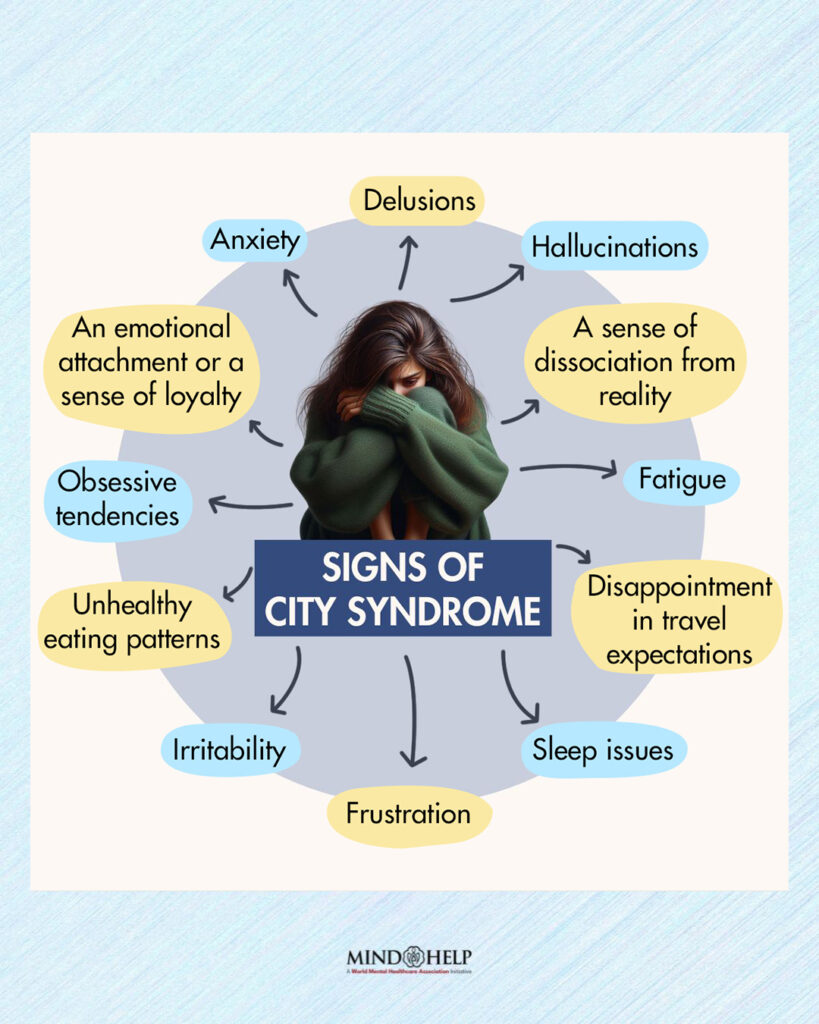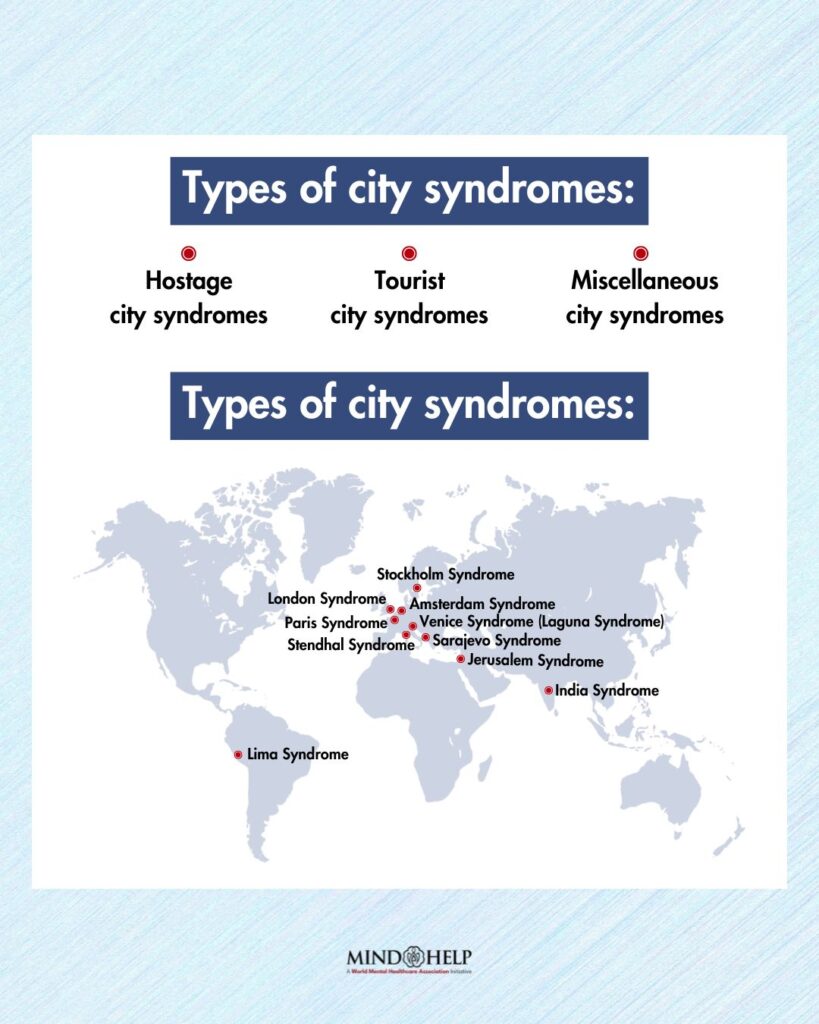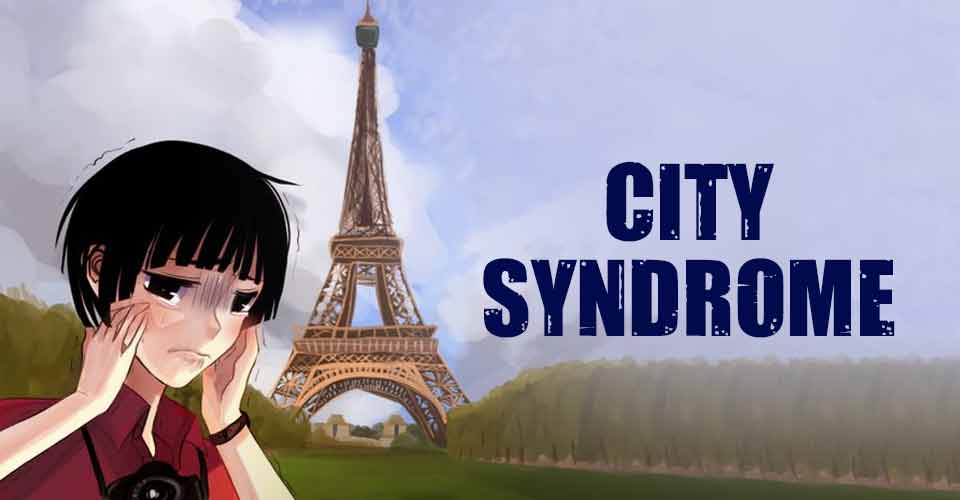Table of Contents
City syndrome refers to a collection of physical and psychological symptoms associated with living in a city. The fast-paced lifestyle, noise pollution, and social isolation in urban environments are believed to contribute to the development of city syndrome.
What Is City Syndrome?
In popular conception, a person with city syndrome experiences a mental affliction characterized by self-centeredness and condescension, upon moving to a major city from a smaller habitat.
In psychology, the term “city syndrome” means short-lived ‘mental states’ induced by specific urban settings. Certain forms of urbanity impose delusions, hallucinations, and other symptoms of psychosis among its residents and visitors. Others experience fatigue, nausea, cardiovascular conditions, and extreme homesickness.
City Syndromes can cause a range of symptoms, such as anxiety, panic attacks, and delusions, among others. While relatively rare, these conditions highlight the complex relationship between individuals and the built environment, and the importance of mental health support for those who experience these conditions.
While cities, in general, have been associated with a wide bevy of mental health conditions (such as anxiety, psychotic, mood, or addictive disorders), city syndromes do not qualify for chronic psychological disorders that require a diagnosis. Instead, these are unusual psychosomatic ‘syndromes’ triggered by factors [mfn] Airault R. (2015). Voyages et risques de décompensations psychiatriques [Risks of psychiatric decompensation in travel]. La Revue du praticien, 65(4), 509–512. [/mfn] like:
- Frequent traveling
- Cultural shock
- Jet-lag
- Difficulty adjusting to a new environment (like a new city)

Types Of City Syndromes
Below are city syndrome examples [mfn] Lawrence Abel, E. (2014). A Note on Psychological Disorders Named After Cities. Names, 62(3), 177–182. https://doi.org/10.1179/0027773814z.00000000087 [/mfn] classified according to the events that occurred within the urban areas that impacted the perceptions of these urban spaces and cultures. There are also cases of unexplained, short-term behavioral disruptions that occur during visits to specific cities.
Some common examples of city syndrome include:
1. Hostage city syndromes
“Hostage” city syndromes draw their names and conception from hostage-related events in cities, as well as the psychological profiles of the hostages/detainees and their captors/detainers.
2. Tourist city syndromes
“Tourist” city syndromes involve syndromes in which touristic influence determines the perceptions of particular urban spaces and cultures.
3. Miscellaneous city syndromes
“Miscellaneous” city syndromes collectively involve unexplained syndromes triggered by particular urban enclaves.
Psychological Conditions Named After Cities

The common city syndromes include:
I. “Hostage” city syndromes
The common types of hostage city syndromes include:
1. Stockholm syndrome
The most famous of “hostage city syndromes” is Stockholm syndrome. It derived its name from a 1973 bank robbery in the Swedish capital that saw bank robbers take four bank employees hostage for six days.
After the negotiated surrender of the robbers, the hostages refused to file charges against their captors and even raised money for their defense.
In psychology, this syndrome became synonymous [mfn] Namnyak, M., Tufton, N., Szekely, R., Toal, M., Worboys, S., & Sampson, E. L. (2008). ‘Stockholm syndrome’: psychiatric diagnosis or urban myth?. Acta psychiatrica Scandinavica, 117(1), 4–11. https://doi.org/10.1111/j.1600-0447.2007.01112.x [/mfn] with situations in which hostages, as a trauma response and coping mechanism, develop a strong emotional connection with their captors during captivity.
2. Lima syndrome
This syndrome stands for the captors’ sympathy for their victims. In 1996, members of the Tupac Amaru Revolutionary Movement took 600 guests at the Japanese Embassy hostage in the Peruvian capital.
However, the captors became so empathetic towards the hostages that the former freed the latter within four months of protracted negotiations.
3. London syndrome
London syndrome is the opposite of Stockholm and Lima syndromes. Inspired by a tragic siege of the Iranian embassy in 1981, in London, wherein nearly all of the 26 hostages died due to violent altercations with the captors or armed intervention by police forces.
This syndrome stands for a deep-seated, suicidal hatred shared by both captors and hostages. The victims do not act on the situation, exhibiting constant resistance and refusal, extreme belligerence, and non-cooperation.
In this case, one or more of the hostages provokes his/her death by arguing or annoying captors, challenging them in physical combat, or trying to escape.
4. Sarajevo syndrome
Sarajevo syndrome is a culture-bound syndrome in which the sufferer experiences an extreme, irrational fear of artillerymen as well as displays the symptoms of post-traumatic stress disorder (PTSD) associated with war and invasion.
Read More About PTSD Here
The syndrome was inspired by the Sarajevo Crisis of 1914, wherein the assassination of Archduke Ferdinand (heir presumptive to the Austro-Hungarian throne) and his wife Sophia, by Bosnian Serb nationalists, sparked World War I. It is more common among the residents of Bosnia-Herzegovina.
II. “Tourist” city syndromes
The common tourist city syndromes include:
1. Paris syndrome
“Paris syndrome” is extremely prevalent among Japanese tourists visiting the French capital. It arises from the jarring confrontation of an ‘ideal’ Paris with the abrasive nature of the city’s inhabitants. Most sufferers experience culture shock, homesickness, mood swings, and physical exhaustion.
2. Jerusalem syndrome
A majority of Christian and Jewish pilgrims visiting the holy city of Jerusalem end up experiencing the “Jerusalem syndrome”. Sufferers develop a strong identity with a character in the Bible and display behaviors similar to Biblical personalities.
They have often been seen sermonizing, shouting on the street, and passionately reading passages from the New or Old Testaments!
3. Stendhal syndrome
Sometimes, tourist city syndromes intersect with aesthetics syndromes. In 1817, during a visit to the Basilica of Santa Croce in Florence, the French author Stendhal entered a fugue state while viewing the artwork.
Years later, in 1979, Italian psychiatrist Graziella Magherini coined the term “Stendhal syndrome” to categorize a common syndrome that tourists experience while touring Florence.
Also known as “Florence syndrome” or “Florentine syndrome”, it is a psychosomatic disorder that involves both psychological and physical symptoms (such as hallucinations, doubt, uncertainty, rapid heartbeat etc.).
Such symptoms tend to occur in a sufferer when they are exposed to events, experiences, artworks or items of significant aesthetic value, beauty, or historical value.
4. Venice syndrome
People suffering from Venice syndrome see Venice as a symbol of death, inspired by Thomas Mann’s novel Death in Venice. The syndrome stands for the behavior of people traveling to Venice with the express intention of committing suicide in the city’s vast canal system.
Most experience depressive symptoms and commit suicide by jumping out of hotel windows, from bridges, or drowning. It is also known as Laguna syndrome.
5. Amsterdam syndrome
Visitors, particularly Italian men, traveling through the Dutch capital briefly develop tendencies to share unconsented nude or intimate pictures of themselves with/without their spouses.
The term was coined in 2008 by sexologist Chiara Simonelli, who drew the concept from Amsterdam’s Red Light District, where prostitutes sit seductively in window areas on display.
6. India syndrome
In “India syndrome”, western travelers to the subcontinent experience a form of psychosis. They abandon their belongings and obsessively wander around the country though disoriented or confused. Experts attribute the condition to a delusional sense of cultural exoticism or the tenacious quest for spiritual enlightenment.
III. “Miscellaneous” city syndromes
The well-known “miscellaneous” city syndromes include:
1. Detroit syndrome
“Detroit syndrome” is drawn from the historical reflection of the “motor city” Detroit’s rising and failing economy. It refers to an age-related discriminatory psychological condition in which an aging employee feels and fears that he/she will be replaced by younger, quicker, stronger, and more skilled workers.
2. Brooklyn syndrome
“Brooklyn syndrome” stands for the inhabitants’ aggressive attitudes toward visitors. Given the city’s amusing tryst with American serial killers in the 1970s, sometimes, the syndrome is used to denote the apparent anti-social traits prevalent amongst the city’s citizens.
Coping With City Syndromes
Cities and mental health conditions have always had a negative relationship. While city syndromes are temporary debilitating conditions triggered by particular urban settings, these are not officially regarded as mental illnesses that mandate clinical diagnosis.
The syndromes go away on their own, with time or with changes in location. A particular city syndrome gets gradually mitigated as the affected individual moves away from the urban setting that particularly caused him/her psychological discomfort.
Certain approaches [mfn] Srivastava K. (2009). Urbanization and mental health. Industrial psychiatry journal, 18(2), 75–76. https://doi.org/10.4103/0972-6748.64028 [/mfn] can help to address and relieve the symptoms of such fleeting mental health disorders. These include:
- Availing short-term medication and therapy
- Practicing relaxation techniques (like deep breathing)
- Considering a few days of bed rest and reduced participation in daily activities
- Traveling back to native countries, under medical supervision
Takeaway
City syndromes are uncommon psychological conditions that can occur sporadically and persist over a person’s lifetime. These episodes can leave the sufferer feeling unable to perform even the most basic tasks, and may also affect their ability to travel or achieve their goals.
However, therapy, medication, and relaxation techniques can be effective in managing the symptoms of city syndromes, offering hope for those who experience this condition.
At A Glance
- “City syndromes” involve psychological conditions induced by certain urban settings.
- Paris syndrome and Stockholm syndrome are popular examples.
- Such syndromes are common among frequent travelers and foreign visitors.
- These syndromes are temporary conditions that go away on their own.
- The chronic symptoms of city syndromes can be easily managed through therapy, medications, and relaxation techniques.
Frequently Asked Questions (FAQs)
1. Why are syndromes named after cities?
Medicine [mfn] Taylor R. B. (2017). Medical Words Linked to Places. The Amazing Language of Medicine: Understanding Medical Terms and Their Backstories, 77–95. https://doi.org/10.1007/978-3-319-50328-8_5 [/mfn] has a long tradition of naming disease syndromes after the places where these were first discovered. In psychology, the term “city syndrome” stands for short-lived ‘mental states’ or psychological conditions induced by specific urban settings.
2. What are other syndromes like Stockholm syndrome?
Like Stockholm syndrome, Paris syndrome, Jerusalem syndrome, and London syndrome are some weird syndromes named after places.
3. Why is Stockholm syndrome called Helsinki syndrome?
The terms “Stockholm syndrome” and “Helsinki syndrome” are often mistakenly used interchangeably to mean the condition in which the hostages develop positive feelings for their captors in captivity. They are not the same. Helsinki syndrome, named after the Finnish capital, stands for a mental condition in which the afflicted person is unable to distinguish between the countries of Sweden and Finland.

